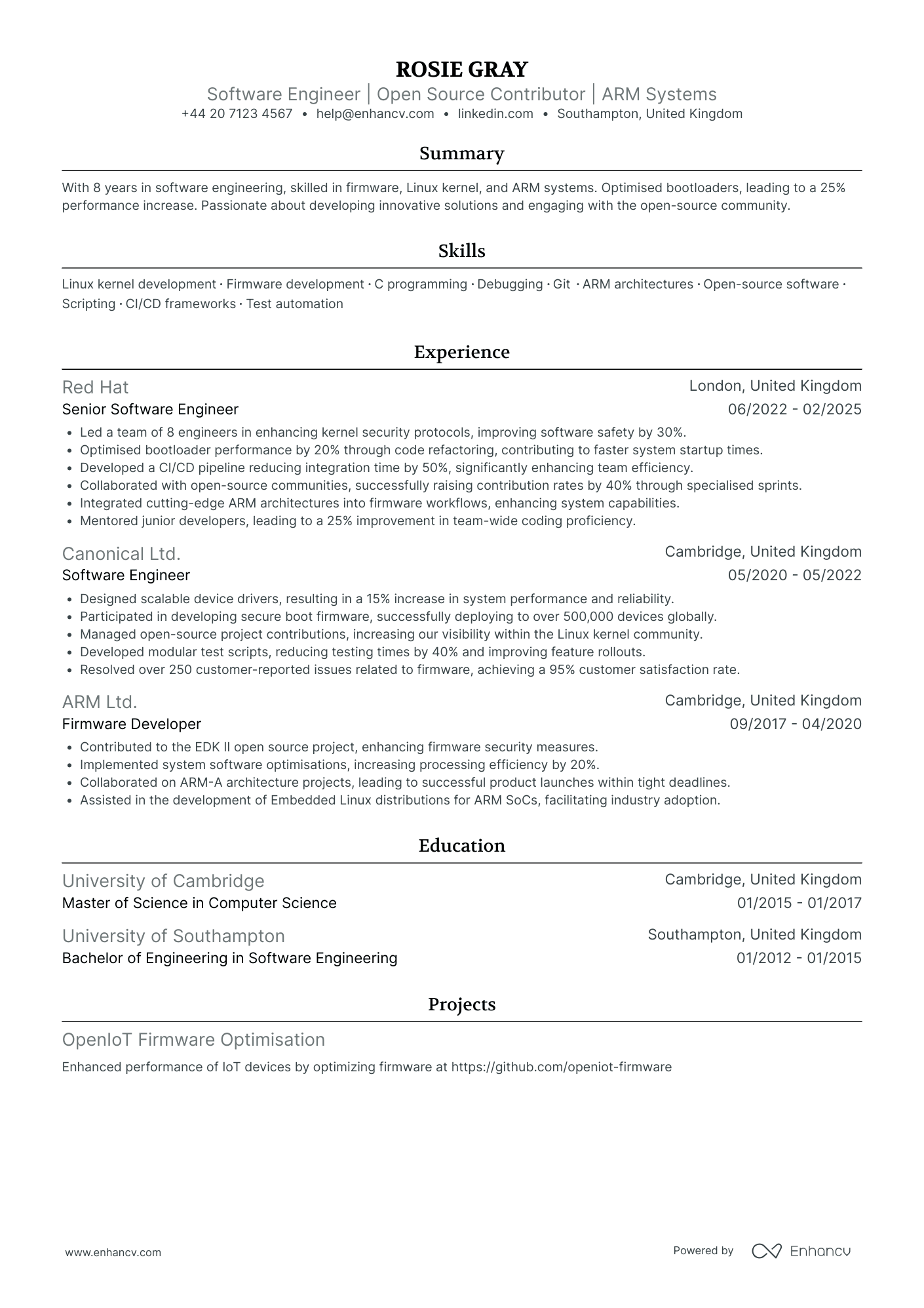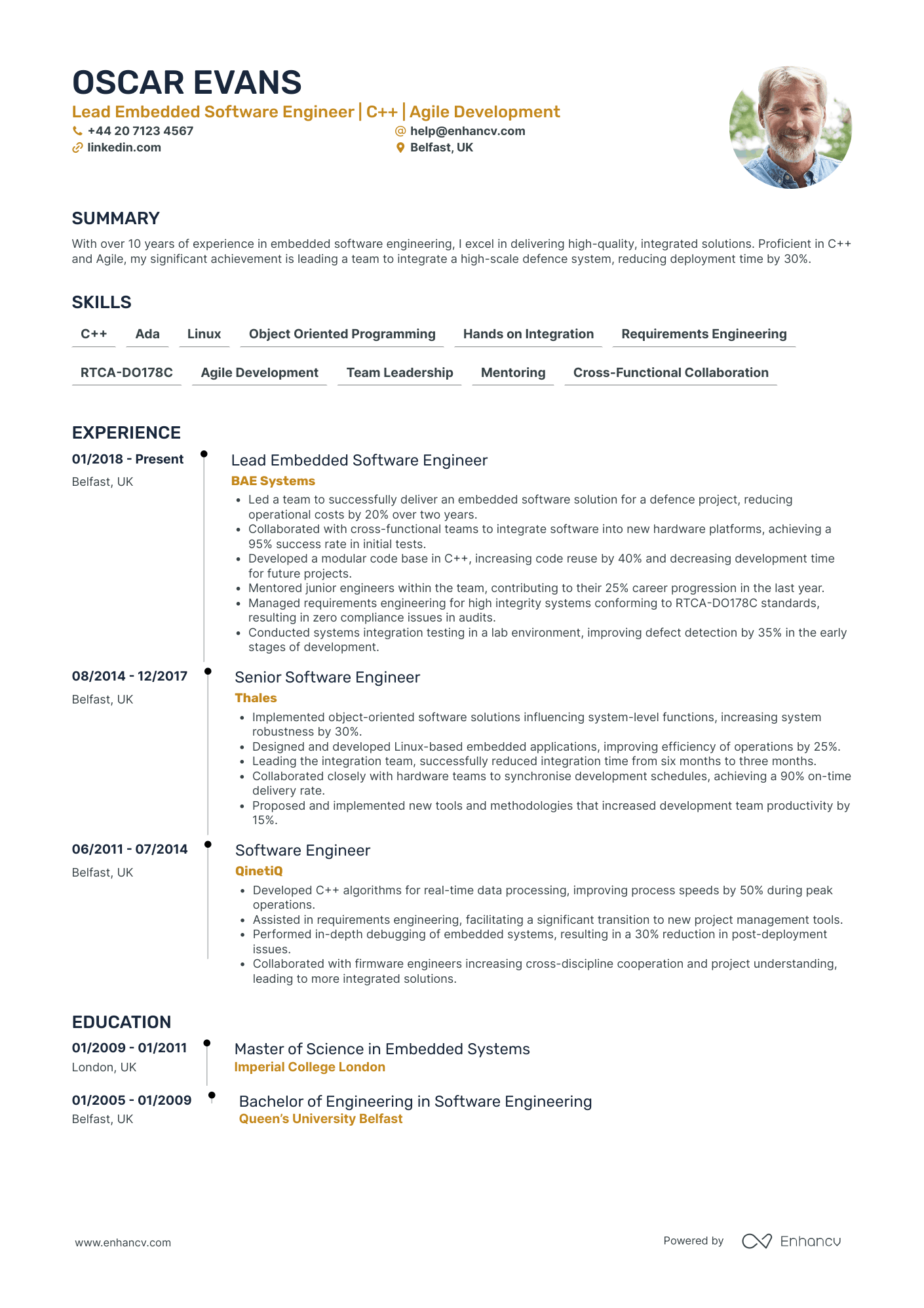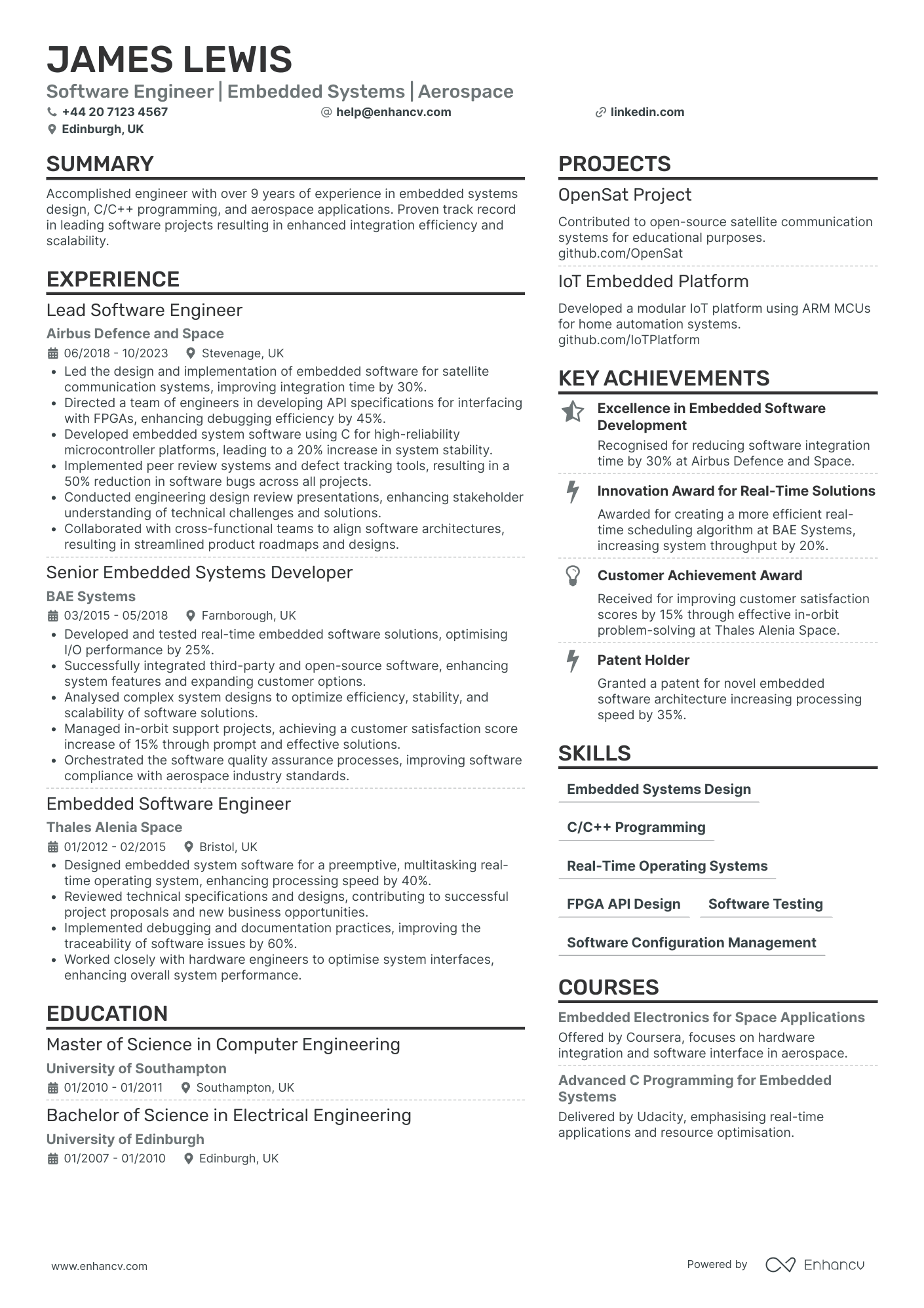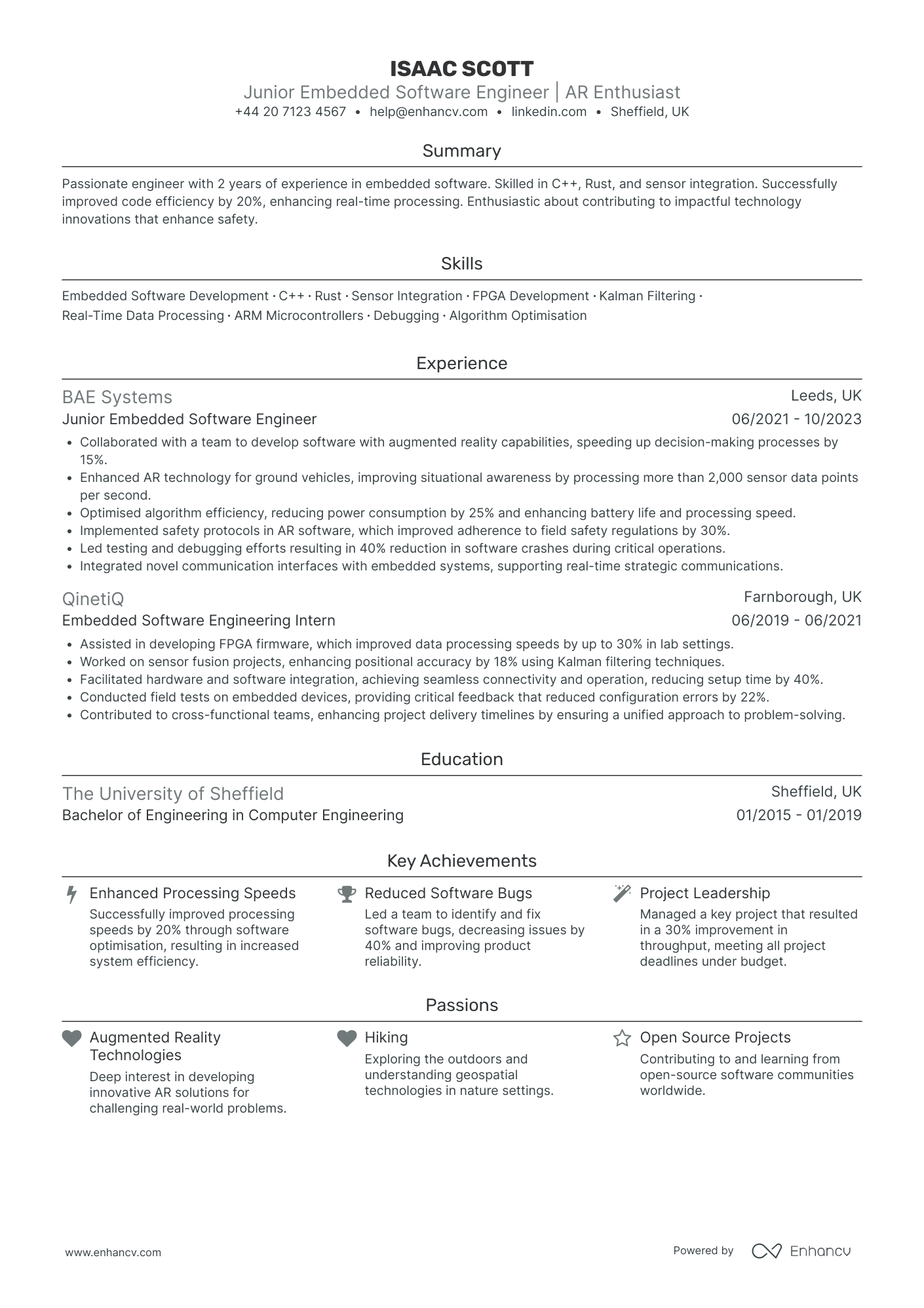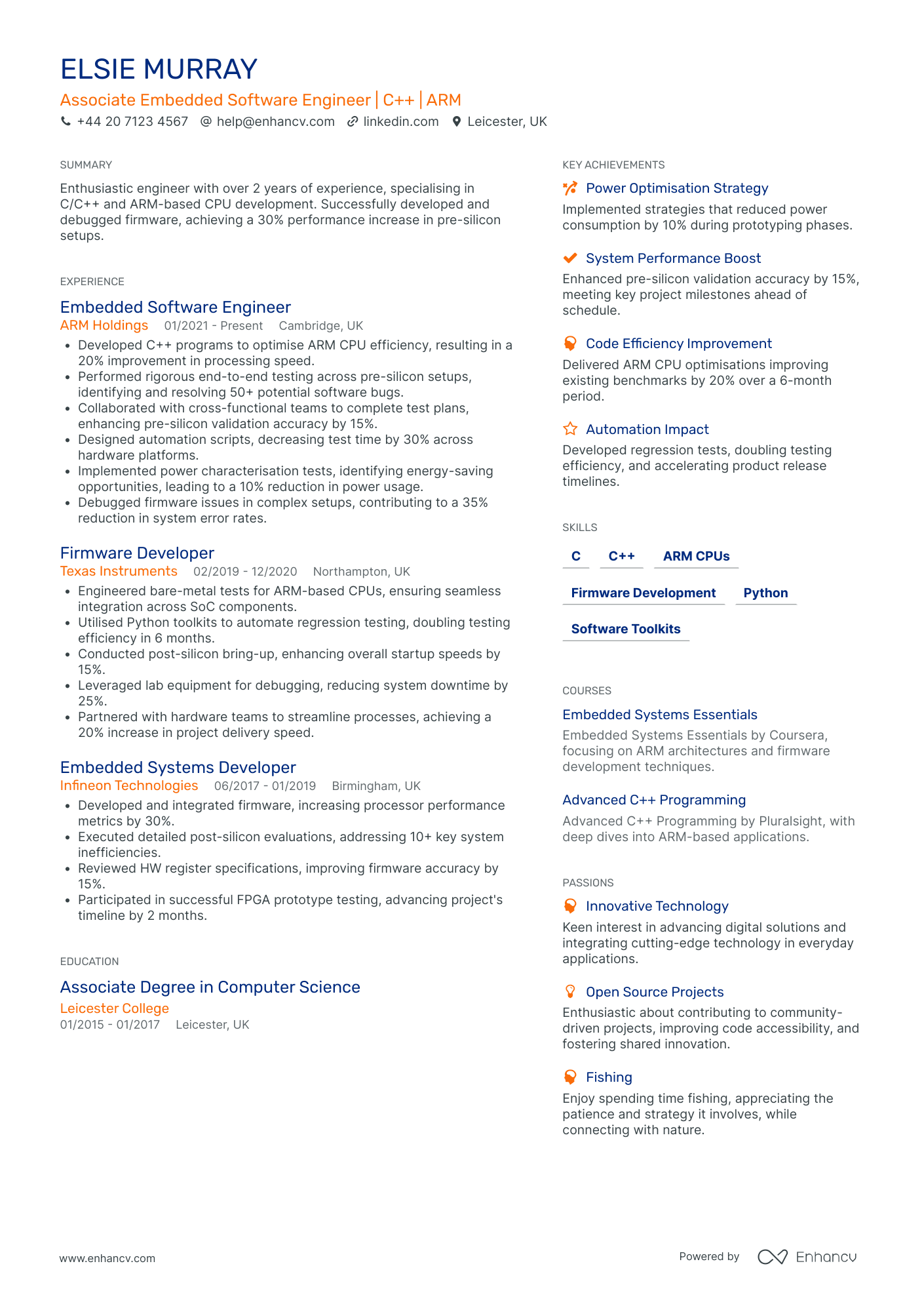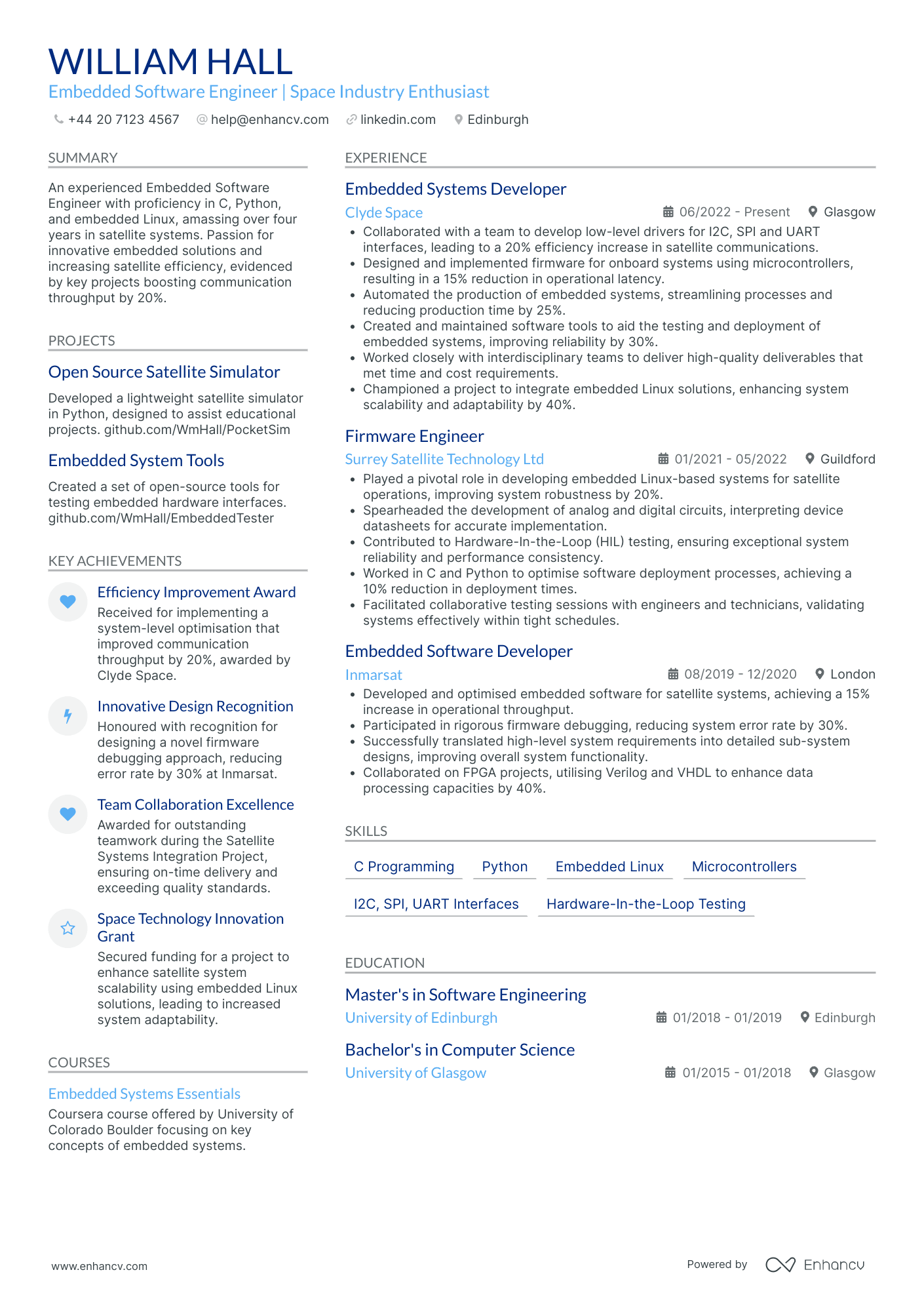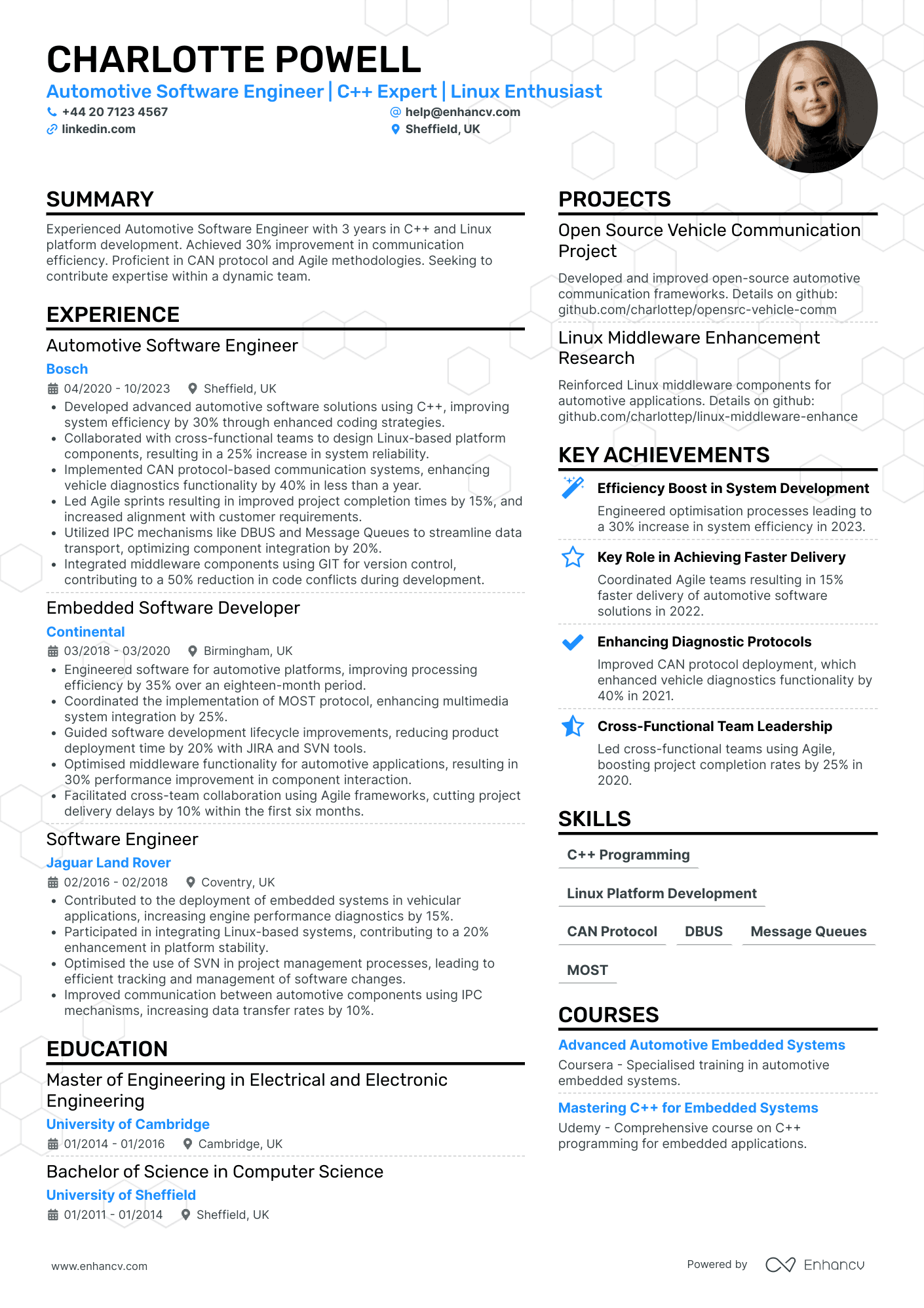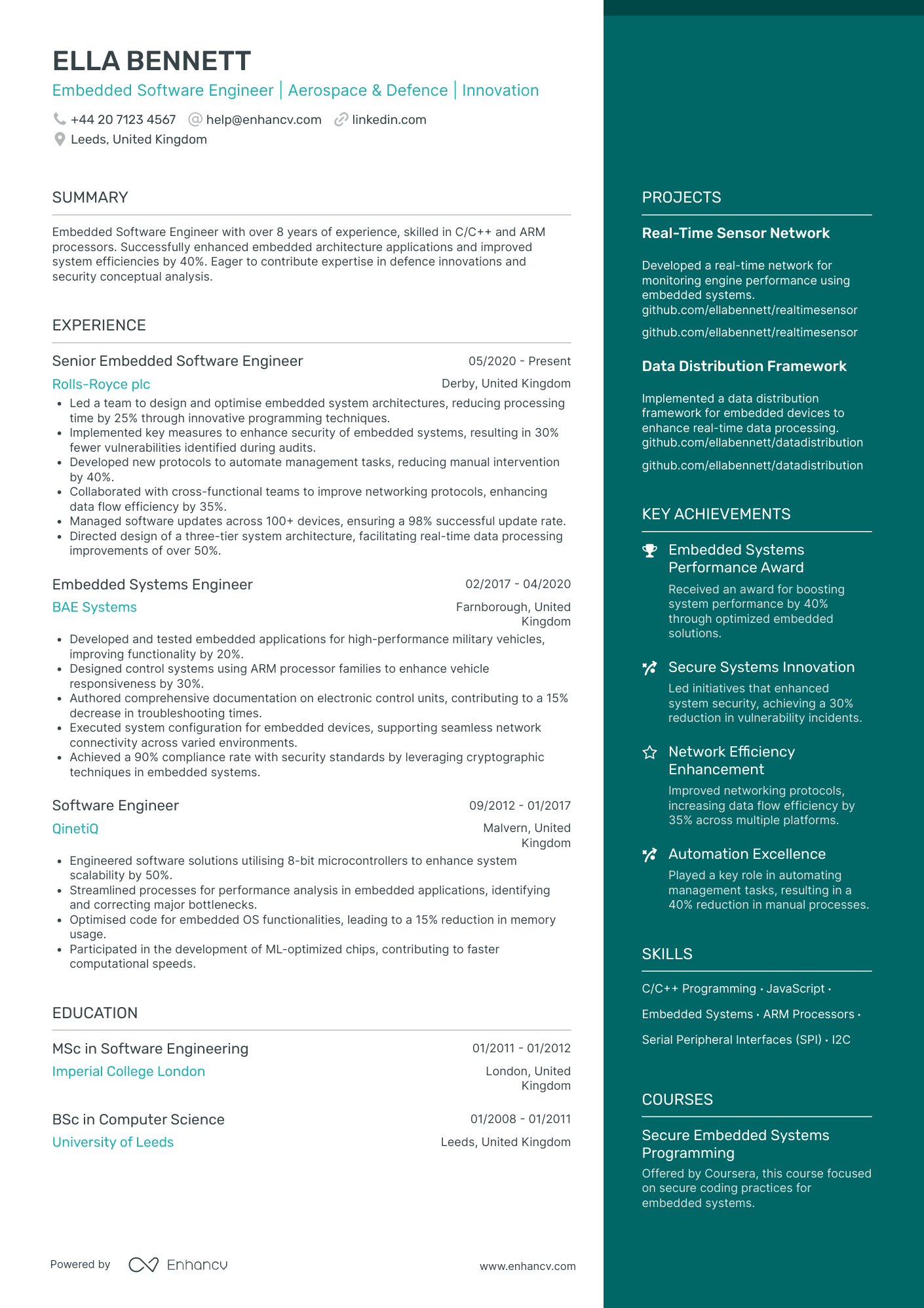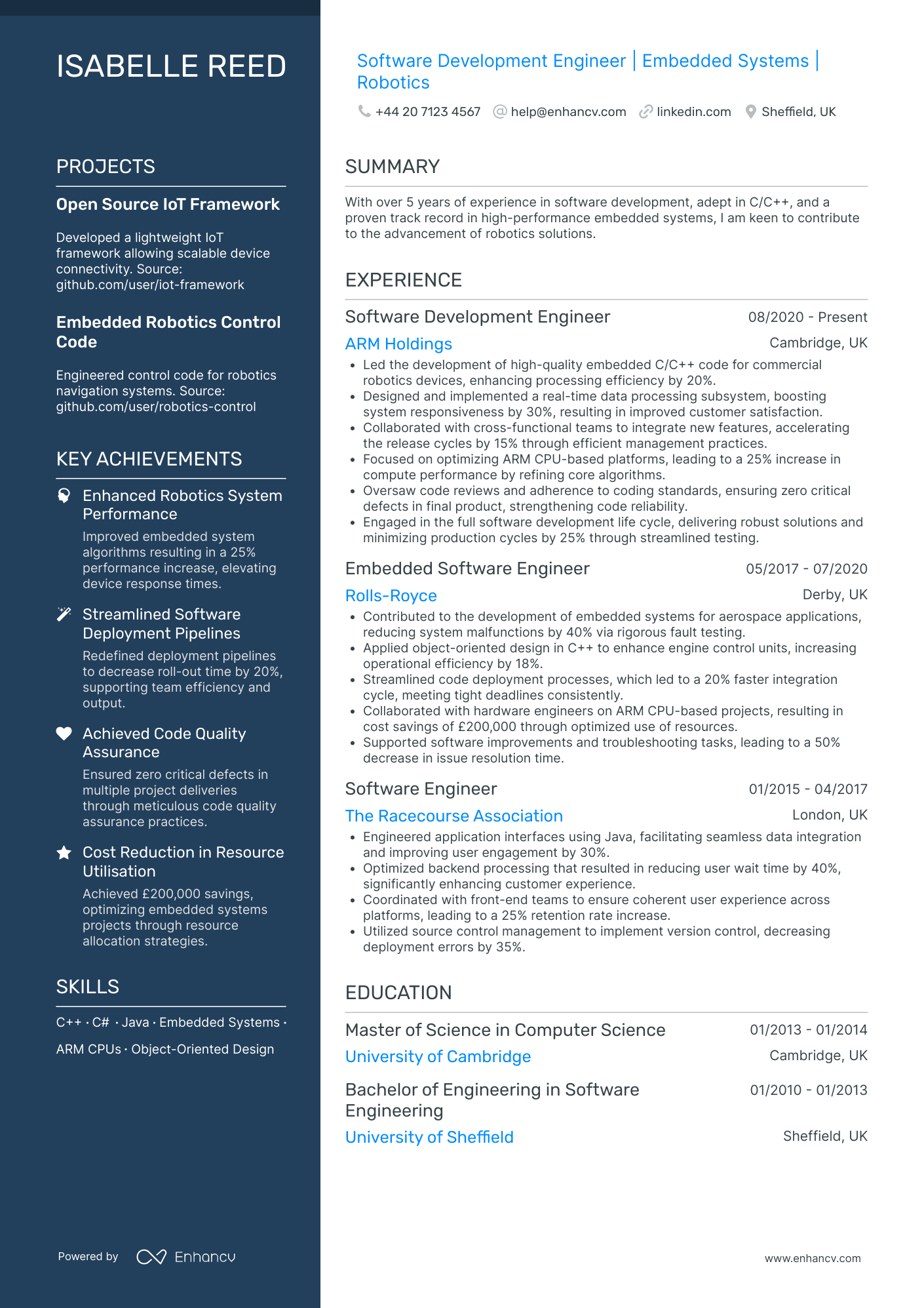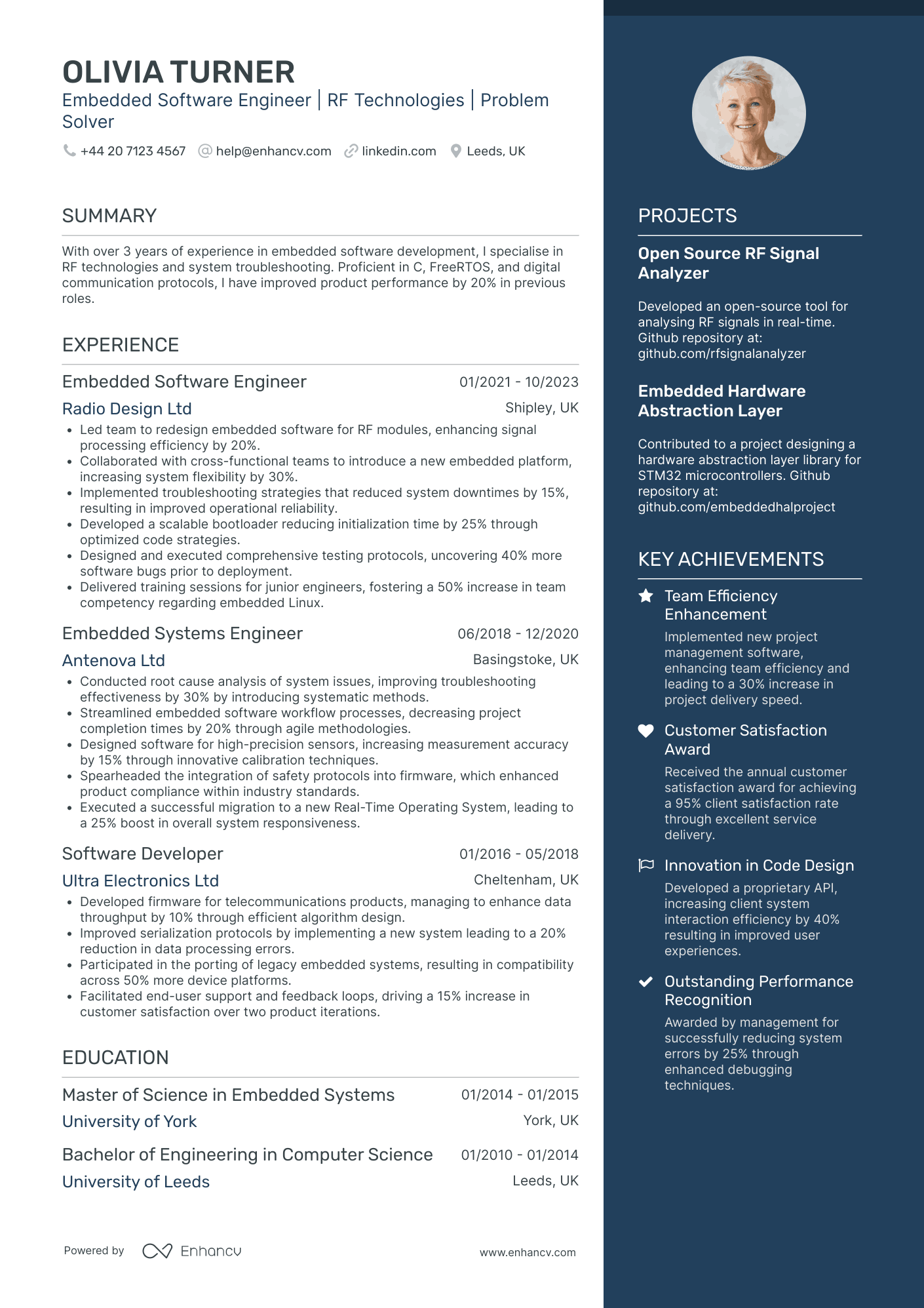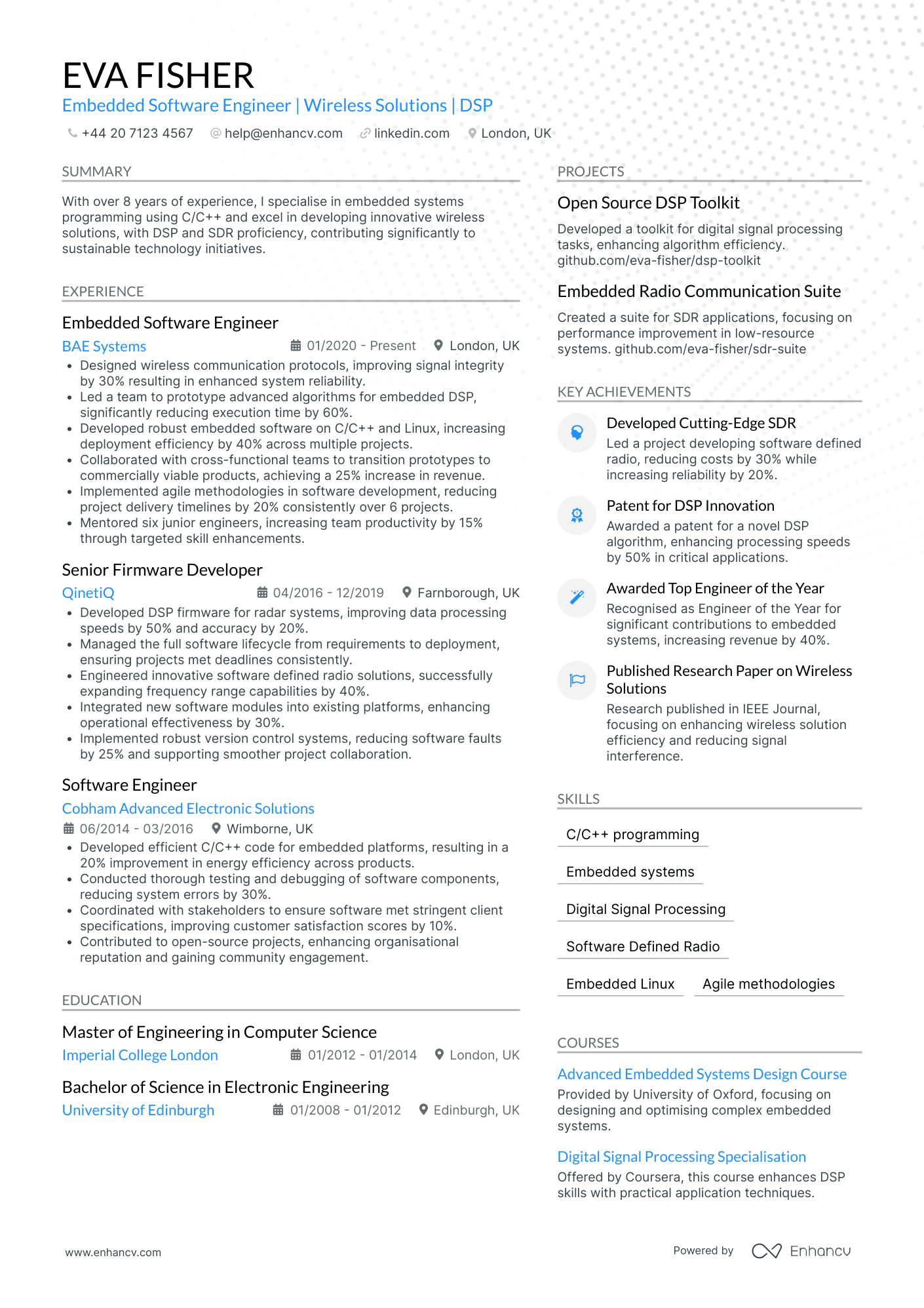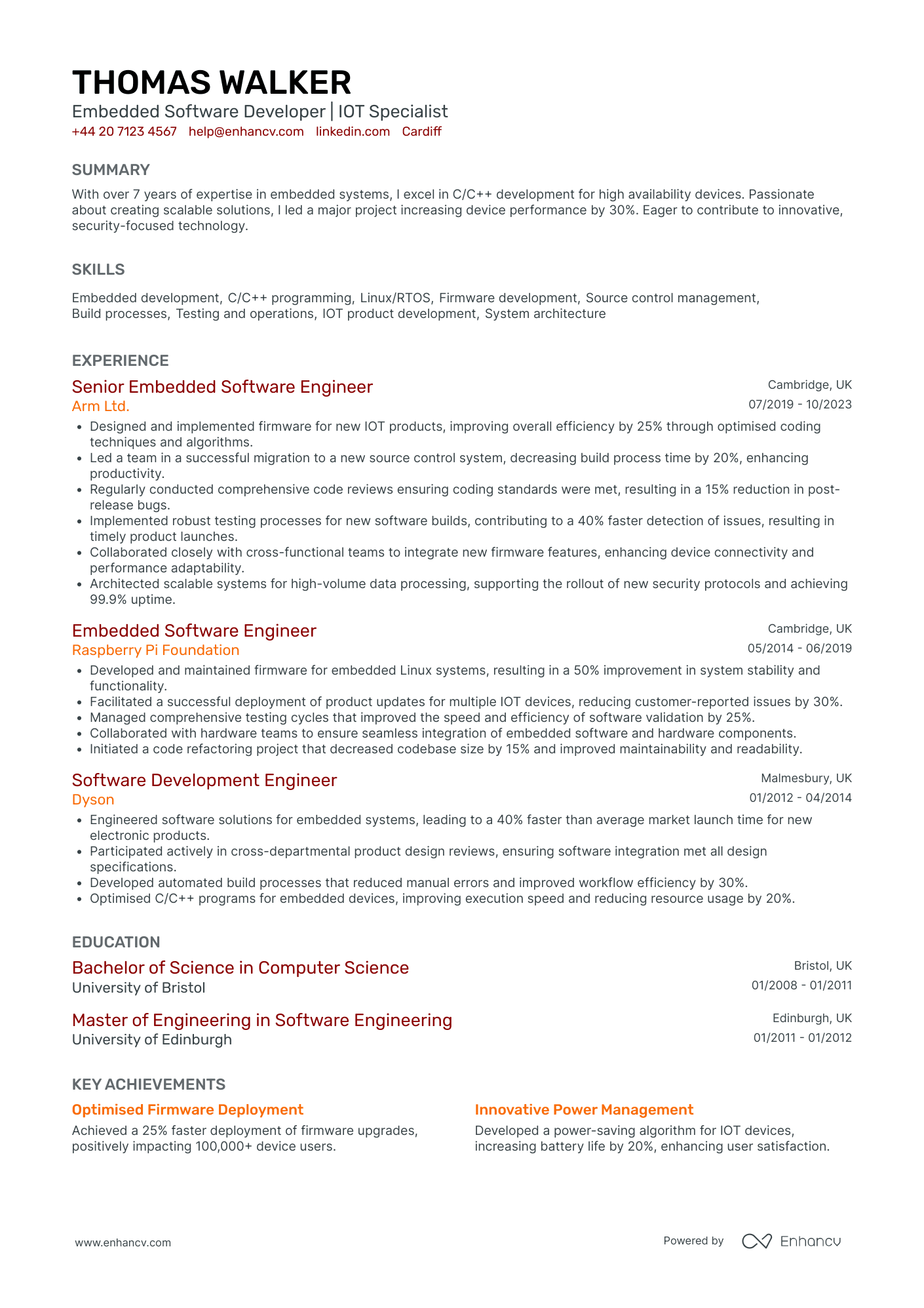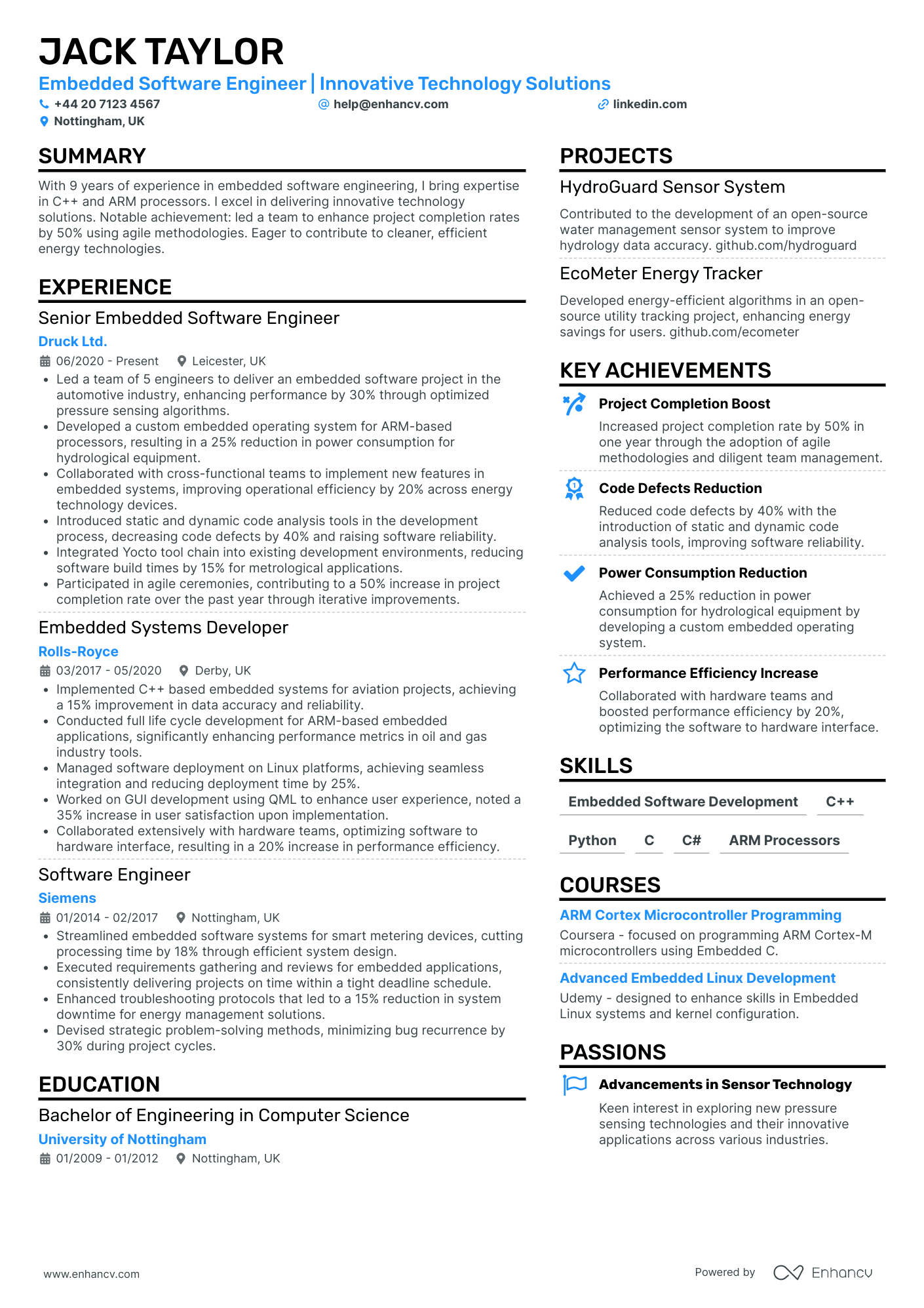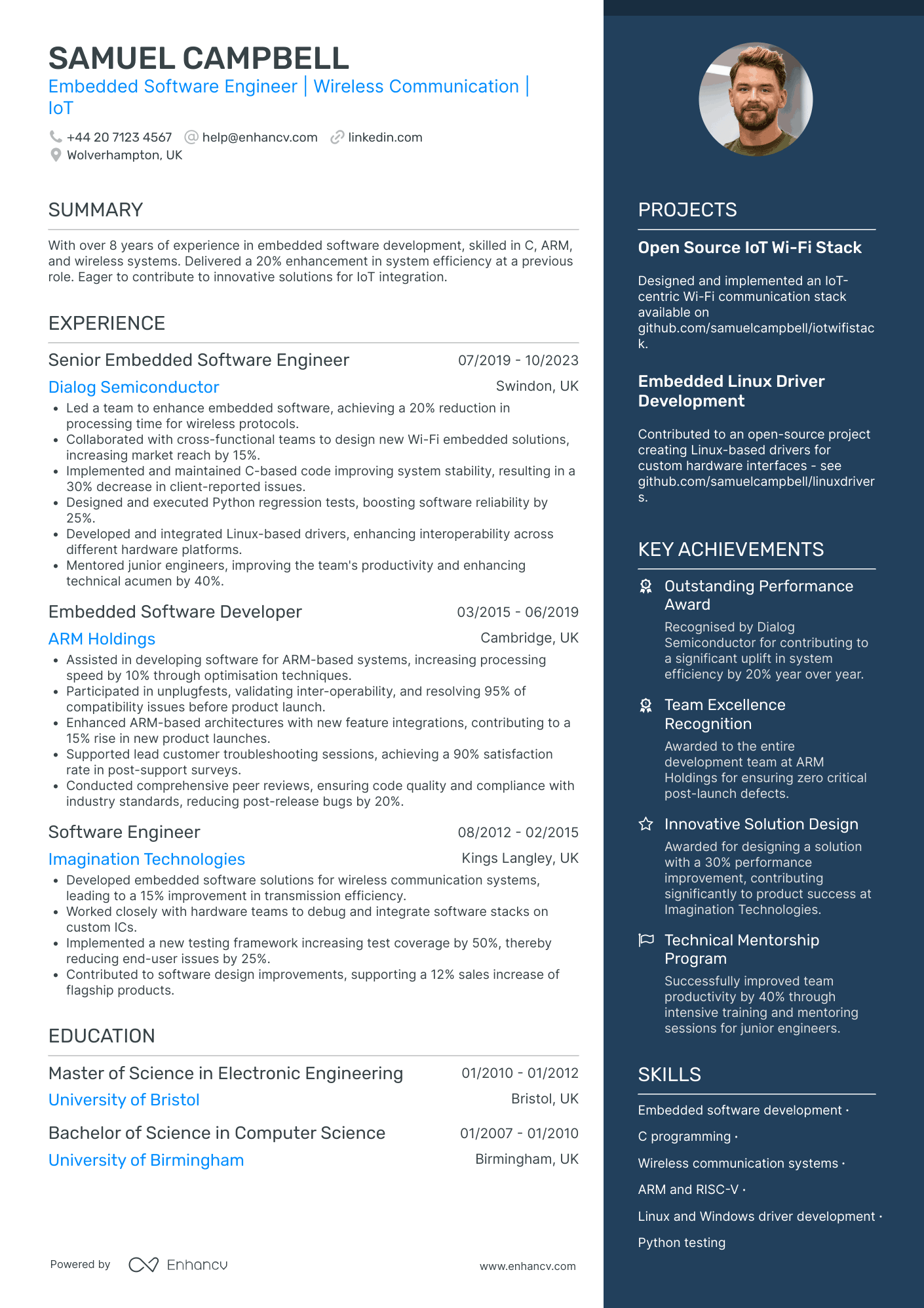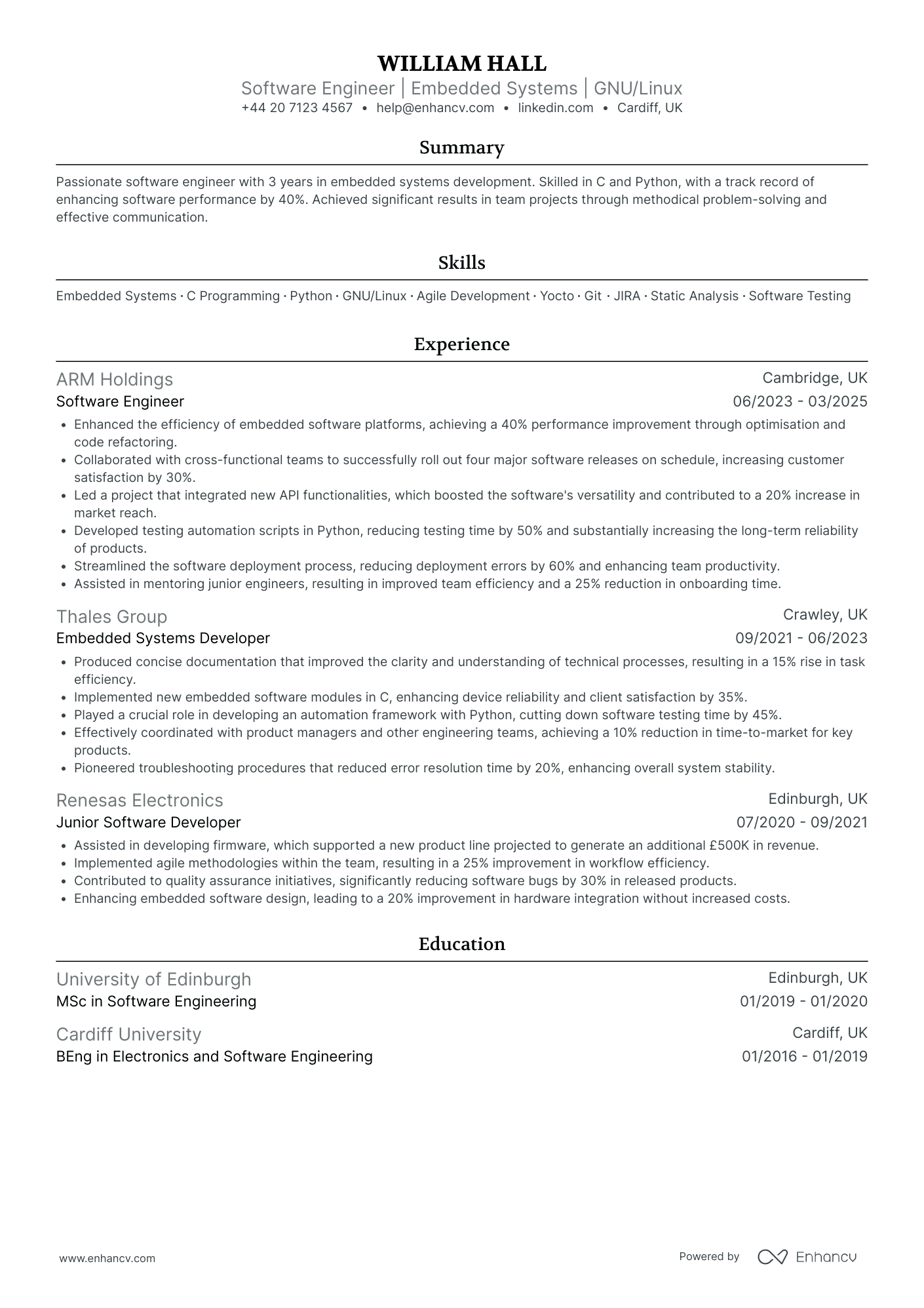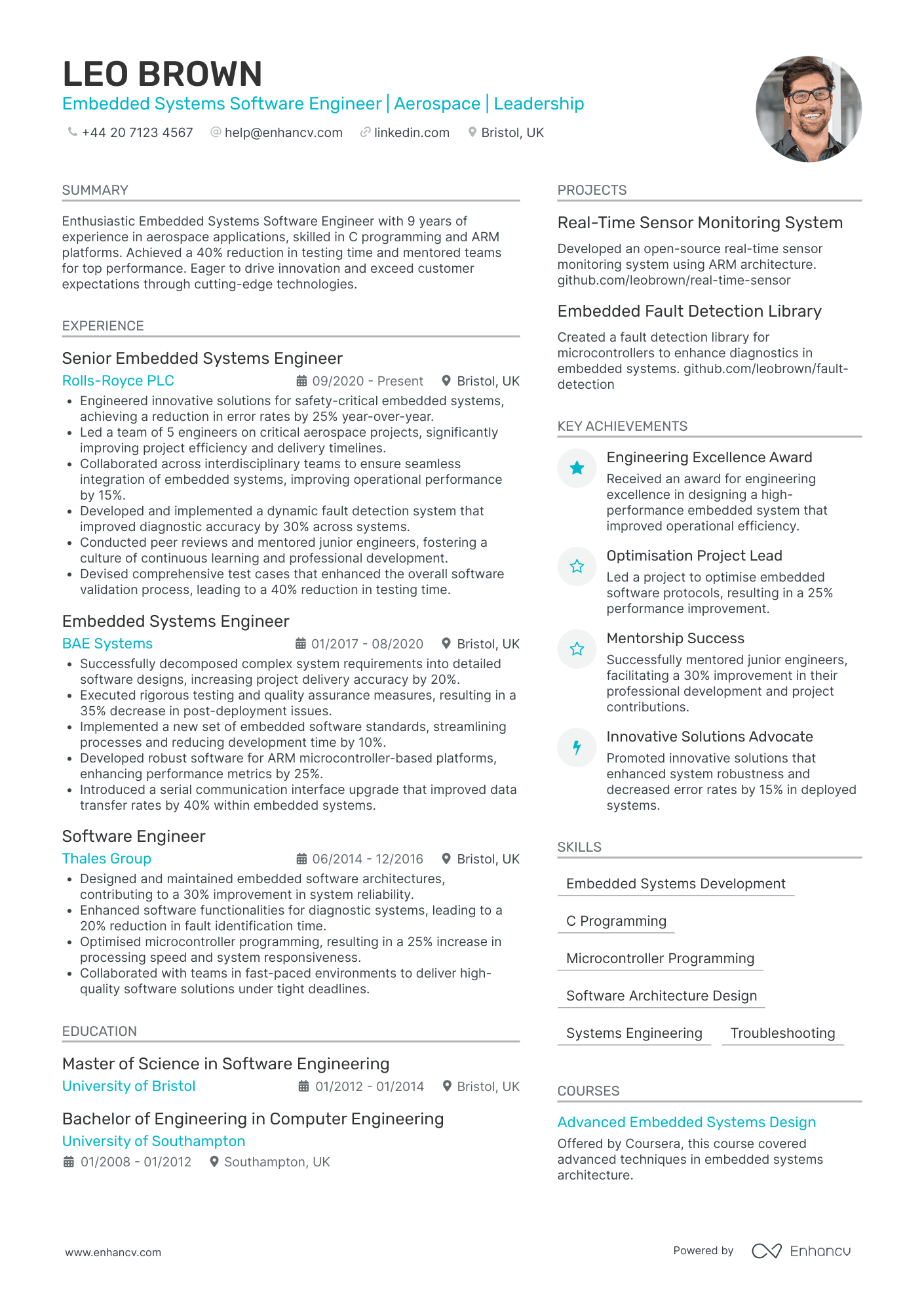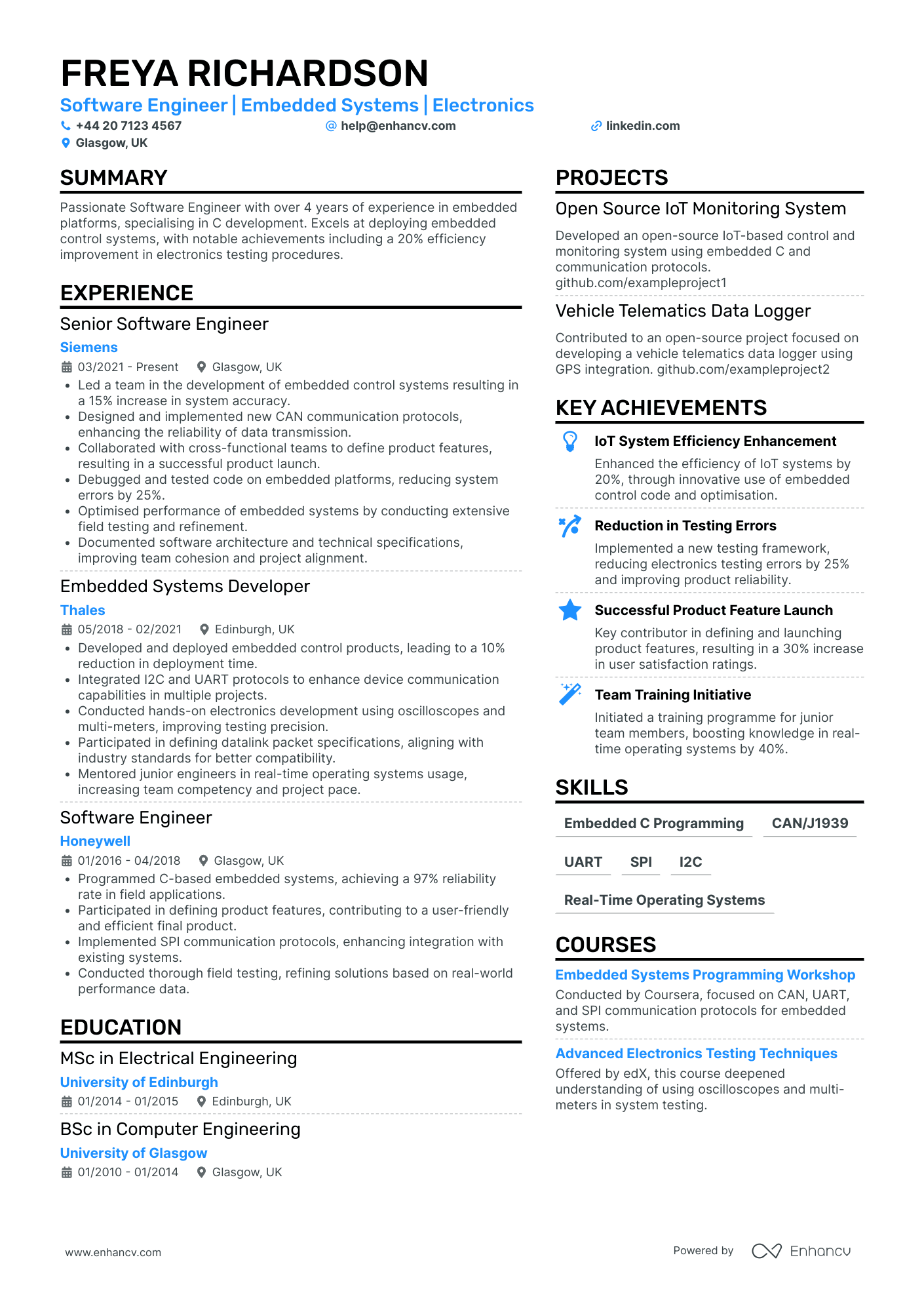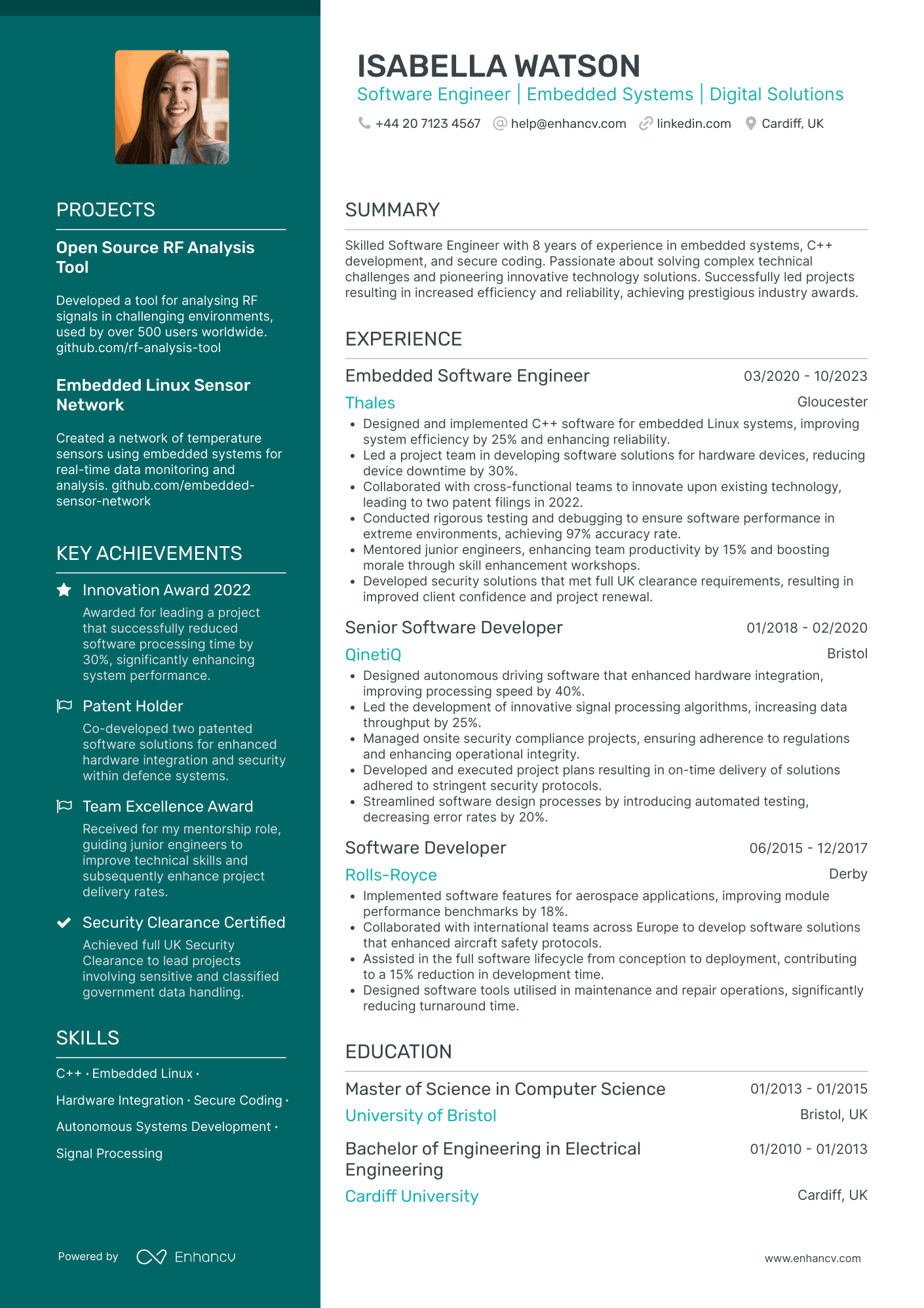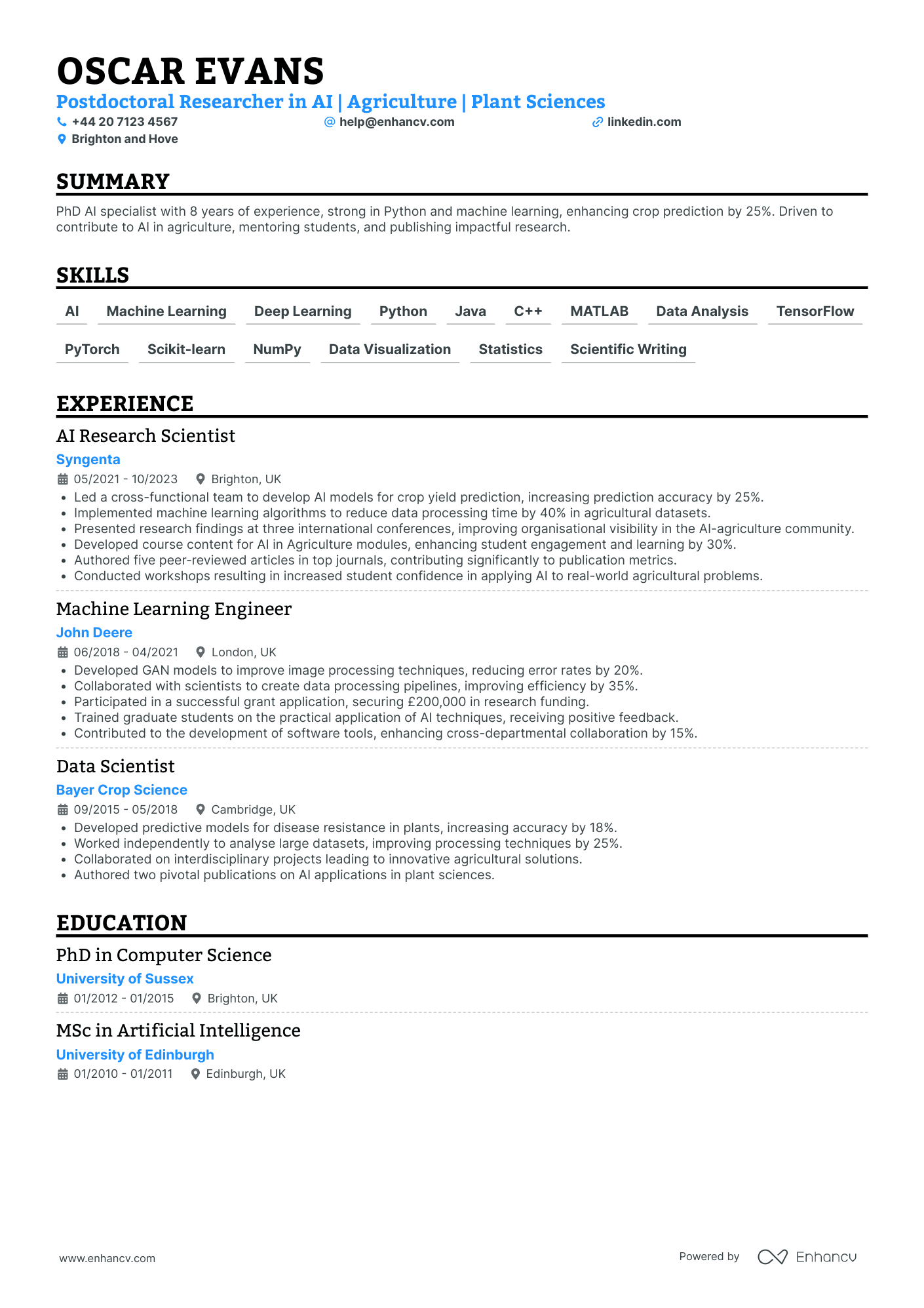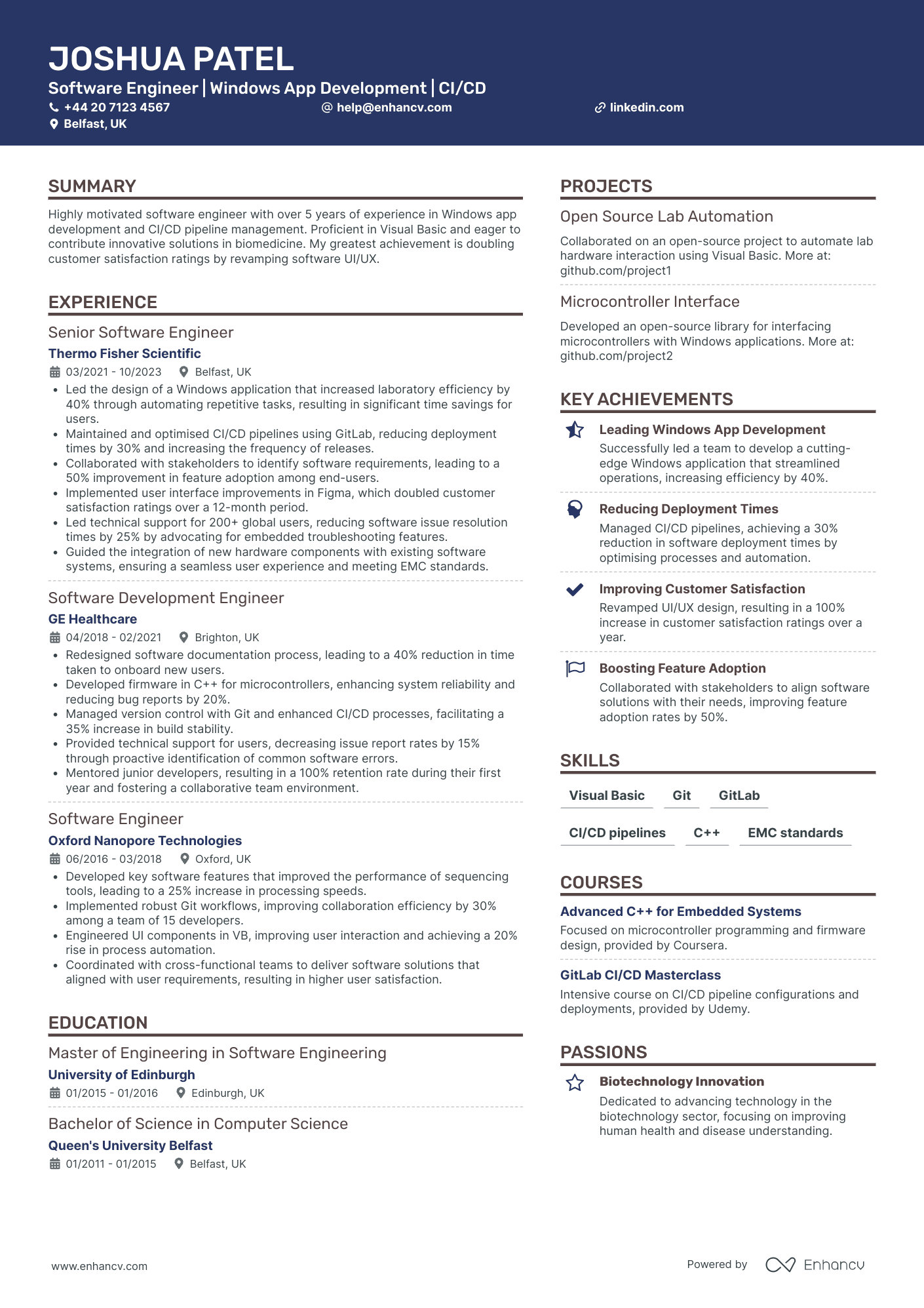Navigating the complexity of real-time system design is a significant CV challenge for embedded software engineers. Our comprehensive guide offers targeted advice and proven strategies to effectively showcase your skills in this area, enhancing your CV's impact.
- Answer job requirements with your embedded software engineer CV and experience;
- Curate your academic background and certificates, following industry-leading CV examples;
- Select from +10 niche skills to match the ideal candidate profile
- Write a more succinct experience section that consists of all the right details.
Do you need more specific insights into writing your embedded software engineer CV? Our guides focus on unique insights for each individual role:
CV examples for embedded software engineer
By Experience
Senior Embedded Software Engineer
- Clear and Structured Content Presentation - The CV is well-organized, presenting each section with concise bullet points that emphasize key accomplishments and responsibilities. This clarity aids quick reading and comprehension, making it easy for employers to identify relevant skills and experiences.
- Impressive Career Trajectory - Rosie's progression from Firmware Developer at ARM Ltd., through a Software Engineer role at Canonical Ltd., to a senior position at Red Hat, reflects strategic career growth and the ability to lead and manage significant technology projects.
- Technical Depth and Specific Industry Tools - The CV highlights Rosie's proficiency in specialized tools and methodologies such as Linux kernel development, ARM architectures, and CI/CD frameworks, demonstrating her in-depth technical knowledge in the tech industry.
Lead Embedded Software Engineer
- Strategic Leadership and Team Development - Oscar's CV clearly showcases his leadership abilities as he progressed from a Senior Software Engineer to a Lead Embedded Software Engineer. His capacity for mentoring team members significantly contributed to their career growth by 25% within a year, highlighting his commitment to developing talent and fostering a productive engineering team.
- Cross-Functional Collaboration and Integration Excellence - A consistent theme throughout the CV is Oscar's adeptness in working across various disciplines. His role in collaborating with cross-functional teams to achieve a 95% success rate in new hardware integrations and synchronizing schedules with hardware teams illustrates his ability to bridge gaps between departments, ensuring cohesive and timely project execution.
- Methodologies and Industry Standards - Proficiency in high integrity systems like RTCA-DO178C and Agile development processes reflects Oscar's technical depth and industry-specific knowledge. These skills enable him to manage complex requirements engineering and integration testing, minimizing compliance issues and improving defect detection, which is crucial for delivering reliable embedded solutions in the defense sector.
Principal Embedded Software Engineer
- Clear and Well-Organized Structure - The CV's structure efficiently highlights key sections such as experience, education, skills, and achievements. Each section is clearly defined, allowing for quick navigation and understanding of James Lewis's professional background and competencies, ensuring that essential information is easily accessible.
- Robust Career Progression - Over the years, James Lewis has demonstrated substantial growth in his career, moving from roles like Embedded Software Engineer to Senior Embedded Systems Developer, eventually becoming a Lead Software Engineer. This trajectory showcases his advancement in expertise and leadership within the aerospace and embedded systems industry.
- Specialized Technical Expertise - This CV emphasizes industry-specific tools and methodologies such as FPGA API Design, C/C++ Programming, and real-time operating systems, which are crucial for roles in aerospace and embedded systems. The inclusion of niche skills and project contributions, like those in satellite communication, underscores his technical depth and relevance to specialized engineering fields.
Junior Embedded Software Engineer
- Clear Structure and Conciseness - The CV is well-structured and concise, starting with a summary that succinctly outlines Isaac's experience and passions. Each section is clearly delineated, making it easy for hiring managers to locate relevant information quickly.
- Significant Career Growth and Specialization - Isaac's career trajectory from an intern at QinetiQ to a Junior Embedded Software Engineer at BAE Systems showcases a clear path of growth and specialization in embedded software and AR technologies, reflecting his commitment to technological innovation and industry impact.
- Industry-Specific Expertise - Isaac demonstrates an impressive grasp of industry-specific tools and methodologies such as C++, Rust, FPGA development, and Kalman filtering, indicating a deep technical proficiency essential for impactful work in real-time processing and sensor integration.
Associate Embedded Software Engineer
- Clear and Concise Presentation - The CV benefits from a structured approach, ensuring that each section is clearly defined and easy to navigate. Bullet points are used effectively to present achievements succinctly, making it accessible for potential employers to quickly understand the strengths and past performances of the candidate.
- Consistent Career Growth - Elsie Murray's career trajectory illustrates a clear path of growth and development within the embedded software engineering field. Transitioning from roles like Embedded Systems Developer to the current position at ARM Holdings reflects a consistent progression towards more complex and influential positions in leading tech companies.
- Technical Proficiency in ARM and C++ - The CV highlights a deep expertise in ARM-based CPU development and C++, which are critical in embedded software engineering. The inclusion of tools like Python, regression testing, and FPGA testing demonstrates a comprehensive understanding of necessary industry methodologies and practices.
Entry-Level Embedded Software Engineer
- Structured Content Presentation - The CV is meticulously organized, offering a clear and concise narrative of the candidate’s qualifications, experience, and achievements. This structured presentation aids in quickly grasping the various aspects of the applicant's career, making it easier for recruiters to identify key qualifications at a glance.
- Clear Career Progression in the Space Industry - William's career trajectory illustrates a clear growth path within the space technology field. Transitioning from roles in embedded software development to more specialized positions in satellite systems, he demonstrates an upward movement in responsibilities, showcasing his commitment and growing expertise in this niche industry.
- Specialized Technical Proficiencies - The CV highlights industry-specific skills such as FPGA Development, Circuit Design, and Hardware-In-the-Loop Testing, indicating a deep technical adeptness essential for the space technology sector. These proficiencies suggest that William can handle complex embedded system challenges effectively.
By Role
Embedded Software Engineer in Automotive
- Clarity and Structured Presentation - The CV is well-structured with clearly defined sections outlining the candidate's qualifications, skills, experience, and achievements. The use of bullet points in the experience section aids in presenting information concisely, allowing for quick and easy reading by potential employers.
- Rich Career Trajectory in Automotive Software - Charlotte Powell's career is marked by significant growth and experience in prestigious automotive companies like Bosch, Continental, and Jaguar Land Rover. This progression showcases her dedication to the automotive industry, with roles advancing from Embedded Software Developer to Automotive Software Engineer, reflecting her increasing expertise and responsibility.
- Depth in Industry-Specific Technologies - The CV highlights a robust proficiency in industry-relevant technologies and methodologies, including advanced skills in C++ programming, Linux platform, CAN protocol, and various IPC mechanisms. Additionally, it underscores her adeptness in using Agile methodologies to foster team collaboration and optimize project outcomes.
Embedded Software Engineer in Aerospace
- Consistent career growth in aerospace and defense - Ella Bennett's CV illustrates a clear, upward career trajectory, with positions progressing from Software Engineer to Senior Embedded Software Engineer. This reflects a dedication to growth within the aerospace and defense industries, underpinned by roles at recognized companies like Rolls-Royce and BAE Systems.
- Use of advanced technical skills and methodologies - The CV highlights specific industry-standard tools and methodologies such as ARM processors, cryptography techniques, and neural networks. These details convey Ella's deep technical expertise in crafting secure and efficient embedded systems, crucial for defense applications.
- Effective communication of achievements and their impact - Achievements are not only quantified but also contextualized, showing how they contribute to broader business objectives. For instance, improvements in data flow efficiency and reductions in vulnerabilities showcase Ella's ability to deliver impactful solutions that benefit organizational performance.
Embedded Software Engineer in Robotics
- Logical and Structured Presentation - This CV is well-organized, beginning with a brief header that clearly outlines the candidate's professional details, including their name, title, location, email, and GitHub profile. The sections follow a logical progression, detailing the candidate's summary, experience, education, skills, courses, projects, achievements, languages, and passions in a concise manner. This helps the reader swiftly navigate through and absorb crucial information.
- Impressive Career Progression - The career trajectory of Isabelle Reed illustrates a steady and consistent growth path in the field of software engineering, particularly focused on embedded systems and robotics. Moving from a Software Engineer in 2015 to a Software Development Engineer at ARM Holdings by 2020 reflects her capacity for handling more responsibilities and mastering increasingly complex technologies. This progression showcases her deepening specialization and trust from employers.
- Technical Acumen and Specialization - The CV stands out with its emphasis on specialized technical expertise in embedded systems and ARM CPU optimization. Isabelle's proficiency in languages such as C++ and Java, combined with her experience in object-oriented design, system optimization, and real-time data processing, implies a robust technical skill set highly relevant to the industry. This technical depth is enhanced by her involvement in projects like the Open Source IoT Framework and Embedded Robotics Control Code.
Embedded Software Engineer in Telecommunications
- Structured Content Presentation - Olivia Turner's CV effectively balances clarity and conciseness, presenting information in a well-organized manner. Each section is clearly defined, allowing for easy navigation and understanding of her credentials, which is essential for recruiters seeking specific qualifications and experiences in embedded software engineering.
- Career Growth and Transition - This CV showcases Olivia's progressive career trajectory, highlighting her growth from a Software Developer to an Embedded Software Engineer. Her progression through different companies demonstrates an upward movement in her career, with an increasing focus on RF technologies and system troubleshooting, showcasing her commitment to specialization and expertise in a niche industry.
- Technical Proficiency and Industry-Specific Skills - Olivia stands out with her in-depth technical knowledge, particularly in C Programming, FreeRTOS, and digital communication protocols. Her engagement in cutting-edge methodologies and tools relevant to the industry, such as developing scalable bootloaders and contributing to open-source RF tools, reflects a high degree of technical competence that is crucial for an Embedded Software Engineer.
Embedded Software Engineer in Defence
- Structured Layout Highlights Clarity and Strengths - The CV is presented in a clear and logical format, making it easy to read and highlighting Eva Fisher’s areas of expertise succinctly. The use of concise bullet points effectively delivers key information about her skills and accomplishments without overwhelming the reader.
- Progressive Career Trajectory with Leadership Roles - Eva Fisher’s career path shows a consistent upward progression, from a Software Engineer to a Senior Firmware Developer, and finally an Embedded Software Engineer with leadership responsibilities. Her roles at leading companies like BAE Systems and QinetiQ demonstrate her growth in the industry and her ability to take on increasing levels of responsibility.
- Innovative Use of Industry-Specific Tools and Methodologies - The CV features detailed mentions of industry-specific methodologies and tools that set Eva apart, such as her proficiency in C/C++ programming, embedded systems design, and the development of wireless solutions. Her involvement in DSP and Software Defined Radio projects highlights her technical depth, which is crucial for her niche field.
Embedded Software Development Engineer
- Logical and Structured Presentation - The CV is clearly structured with sections such as summary, experience, education, skills, and achievements. This logical flow makes it easy for the reader to locate relevant information quickly, enhancing the overall clarity and professionalism of the document.
- Progressive Career Development - Thomas Walker's career trajectory reflects significant growth, beginning as a Software Development Engineer and advancing to a Senior Embedded Software Engineer at a leading tech company. This progression demonstrates his ability to take on more complex responsibilities and leadership roles over time.
- Technical Proficiency in Embedded Systems - The CV highlights Walker's deep industry-specific knowledge, such as C/C++ programming, Linux/RTOS, and firmware development. These specialized skills indicate a high level of technical expertise crucial for the role of an Embedded Software Developer.
Embedded Software Engineer in Medical Devices
- Structured and Clear Presentation - The CV is well-organized, with clear headings and sections that guide the reader seamlessly through the candidate's professional journey, skills, and achievements. It concisely presents significant information while avoiding unnecessary detail, enhancing readability and impact.
- Impressive Career Progression - Jack Taylor’s career trajectory showcases a consistent rise from a Software Engineer at Siemens to a Senior Embedded Software Engineer at Druck Ltd., reflecting growth and expertise in embedded systems. This progression indicates a strong commitment to professional development and mastery of increasingly complex roles.
- Advanced Technical Proficiency - This CV highlights extensive use of industry-specific tools and methodologies, including Yocto tool chains, ARM Processors, and QML, showcasing Jack’s deep technical knowledge and adaptability within the realm of embedded software engineering. These elements underscore his capability to execute and innovate in sophisticated technological environments.
Embedded Software Engineer in IoT
- Clear and Structured Presentation - The CV is organized in a manner that clearly highlights Samuel's qualifications, expertise, and achievements. Sections such as experience, education, skills, and projects are laid out logically, allowing for easy navigation and understanding of Samuel’s professional background.
- Progressive Career Trajectory - Samuel's career demonstrates impressive growth and continuous advancement within the embedded software engineering field. He has progressed from a Software Engineer at Imagination Technologies to a Senior Embedded Software Engineer at Dialog Semiconductor, highlighting his increasing responsibility and expertise in the industry.
- Technical Proficiency and Industry-Specific Tools - Samuel's CV showcases a strong command of industry-specific tools and methodologies, such as C programming, ARM systems, wireless communication protocols, and Linux driver development, reflecting his deep technical knowledge and specialization in the field.
Embedded Software Engineer in Industrial Automation
- Clear Structure and Conciseness - William Hall's CV is organized with precision, where each section is tailored to highlight specific attributes of the candidate. The clarity in the presentation of work experience with succinct bullet points ensures that the reader can quickly comprehends his capabilities and contributions.
- Career Growth and Industry Engagement - The progression from Junior Software Developer to Software Engineer within prominent companies like ARM Holdings and Thales Group demonstrates his upward career trajectory and deep commitment to the field of embedded systems. His educational path aligns with his career moves, emphasizing a strong foundation in electronics and software engineering.
- Technical Expertise and Specialized Skills - William stands out by showcasing his proficiency in high-demand domains such as Embedded Systems, C Programming, and GNU/Linux. His involvement in niche areas like Yocto and static analysis underscores a specialized knowledge that is critical in the software engineering landscape.
Embedded Systems Software Engineer
- Strong Leadership and Mentoring - The CV highlights Leo's leadership skills evidenced by leading a team of engineers at Rolls-Royce and mentoring junior engineers to achieve significant growth in their professional development, fostering a culture of continuous learning.
- Adaptability Across Organizations - Leo’s career trajectory shows adaptability and progression through significant roles in different high-profile aerospace companies such as Rolls-Royce PLC, BAE Systems, and Thales Group, underscoring his ability to thrive and contribute positively in diverse environments.
- Impressive Technical Proficiency - The CV shines with industry-specific expertise in embedded systems, reflected in projects involving ARM microcontroller programming and safety-critical systems engineering, showcasing deep technical competence that is highly relevant to aerospace applications.
Embedded Software Engineer in Consumer Electronics
- Structured and Comprehensive Layout - The CV is exceptionally well-organized, presenting information in a clear and concise manner. Each section is separated logically, allowing for easy navigation, with details like experience, education, skills, and projects clearly demarcated, providing a complete picture succinctly.
- Continuous Professional Growth - Freya Richardson's career trajectory highlights a consistent upward mobility. Beginning as a Software Engineer and progressing to a Senior role at Siemens, there is clear evidence of professional development, indicating both expertise and ambition in the field of embedded systems.
- Technical Proficiency in Embedded Systems - The document emphasizes industry-specific skills, like embedded C programming and communication protocol mastery including CAN, UART, SPI, and I2C, showcasing not only the depth of knowledge but the ability to employ these tools for substantial improvements in electronic testing and system efficiency.
Embedded Software Engineer in Energy
- Structured Career Progression - Isabella's career trajectory is clearly outlined, showcasing a seamless progression from Software Developer roles to significant positions like Senior Software Developer and Embedded Software Engineer. This reflects a strong upward movement and adaptability across different companies, each time assuming greater responsibility.
- Technical Expertise in Niche Areas - The CV highlights in-depth knowledge of embedded systems, secure coding, and specific industry tools like C++, Embedded Linux, and FPGA. Her specialized skill set is critical for roles requiring advanced technical capabilities, making her a strong candidate for positions that need deep technological insight.
- Cross-Functional Leadership and Mentorship - Isabella demonstrates strong leadership qualities through her experience in mentoring junior engineers and leading multi-disciplinary project teams. Her ability to collaborate across functions and drive team productivity is an asset for any technical leadership position.
Embedded Software Engineer in Agriculture
- Effective Presentation of Content - The CV excels in clarity and structure, with a well-organized format that allows for easy navigation through Oscar's experiences, skills, and achievements. Key sections like education, experience, and projects are clearly delineated, making it simple to assess his qualifications at a glance.
- Robust Career Trajectory - Oscar's career demonstrates impressive growth, moving from positions like Data Scientist to AI Research Scientist. This progression not only highlights his capacity for rapid learning and advancement in the agricultural tech industry but also his adaptability to evolving technologies.
- Industry-Specific Expertise - The CV features unique elements that underline Oscar's specialization in agricultural technologies. His experience with machine learning models specific to crop yield prediction and disease detection showcases his technical depth and commitment to addressing sector-specific challenges.
Embedded Software Engineer in Biotechnology
- Structured Career Development and Specialization - Joshua’s career trajectory showcases a clear progression through increasingly senior roles, from Software Engineer to Senior Software Engineer, signifying acknowledgment of his technical prowess and leadership capabilities. He demonstrates a specialized focus on app development and CI/CD processes, particularly within the biomedical industry, which illustrates his commitment to specific technical domains and industries.
- Integration of Advanced Tools and Methodologies - The CV highlights Joshua's adept use of industry-standard tools and methodologies, such as Git, GitLab, and Figma, as well as his ability to implement CI/CD pipelines and manage EMC standards. His technical depth is further underscored by his courses in advanced C++ and GitLab CI/CD configurations, which provide him with a solid foundation to enhance efficiency and drive innovation in software projects.
- Significant Achievements with Tangible Business Impact - Across his experiences, Joshua’s achievements reflect significant business contributions, such as increasing laboratory efficiency by 40% through automation and enhancing customer satisfaction through revamping UI/UX. These accomplishments not only highlight his technical and design skills but also his ability to translate these into real-world impacts that align with business objectives and user needs.
How complex should the format of your embedded software engineer CV be?
Perhaps, you decided to use a fancy font and plenty of colours to ensure your embedded software engineer CV stands out amongst the pile of other candidate profiles. Alas - this may confuse recruiters. By keeping your format simple and organising your information coherently, you'll ultimately make a better impression. What matters most is your experience, while your CV format should act as complementary thing by:
- Presenting the information in a reverse chronological order with the most recent of your jobs first. This is done so that your career history stays organised and is aligned to the role;
- Making it easy for recruiters to get in touch with you by including your contact details in the CV header. Regarding the design of your CV header, include plenty of white space and icons to draw attention to your information. If you're applying for roles in the UK, don't include a photo, as this is considered a bad practice;
- Organising your most important CV sections with consistent colours, plenty of white space, and appropriate margins (2.54 cm). Remember that your CV design should always aim at legibility and to spotlight your key information;
- Writing no more than two pages of your relevant experience. For candidates who are just starting out in the field, we recommend to have an one-page CV.
One more thing about your CV format - you may be worried if your double column CV is Applicant Tracker System (ATS) complaint. In our recent study, we discovered that both single and double-column CVs are ATS-friendly . Most ATSes out there can also read all serif and sans serif fonts. We suggest you go with modern, yet simple, fonts (e.g. Rubik, Lato, Raleway) instead of the classic Times New Roman. You'll want your application to stand out, and many candidates still go for the classics. Finally, you'll have to export your CV. If you're wondering if you should select Doc or PDF, we always advise going with PDF. Your CV in PDF will stay intact and opens easily on every OS, including Mac OS.

PRO TIP
Use bold or italics sparingly to draw attention to key points, such as job titles, company names, or significant achievements. Overusing these formatting options can dilute their impact.
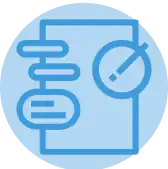
The top sections on a embedded software engineer CV
- Technical Skills showcase your expertise in programming languages and embedded systems.
- Work Experience details your previous roles and specific projects you worked on.
- Education and Certifications highlight your academic qualifications and any relevant certifications.
- Personal Projects demonstrate practical experience with hands-on embedded software development.
- Professional Affiliations indicate memberships with technical societies or groups within the industry.
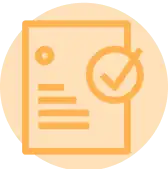
What recruiters value on your CV:
- Highlight relevant technical skills such as proficiency in C/C++, real-time operating systems (RTOS), microcontroller architectures, and familiarity with communication protocols like SPI, I2C, CAN, and UART.
- Detail any experience with hardware debugging tools like oscilloscopes, logic analysers, and JTAG debuggers to convey your hands-on problem-solving abilities with embedded systems.
- Include successful projects where you've optimised code for performance or memory constraints, demonstrating your ability to write efficient and resource-conscious software.
- Present examples of your involvement in the full product lifecycle, from concept and design to implementation and testing, showcasing a comprehensive understanding of embedded software development.
- Mention any contributions to open-source projects or personal projects that involve embedded systems or IoT devices, as these can serve as practical evidence of your passion and expertise in the field.
Recommended reads:
Making a good first impression with your embedded software engineer CV header
Your typical CV header consists of Your typical CV header consists of contact details and a headline. Make sure to list your professional phone number, email address, and a link to your professional portfolio (or, alternatively, your LinkedIn profile). When writing your CV headline , ensure it's:
- tailored to the job you're applying for;
- highlights your unique value as a professional;
- concise, yet matches relevant job ad keywords.
You can, for examples, list your current job title or a particular skill as part of your headline. Now, if you decide on including your photo in your CV header, ensure it's a professional one, rather than one from your graduation or night out. You may happen to have plenty more questions on how to make best the use of your CV headline. We'll help you with some real-world examples, below.

Examples of good CV headlines for embedded software engineer:
- Embedded Software Engineer | Real-Time Systems Specialist | ARM Architecture | 5+ Years of Expertise
- Senior Embedded Developer | C/C++ Proficient | IoT Innovations | MSc in Computer Science | 10 Years’ Experience
- Principal Firmware Engineer | Embedded Linux | Hardware-Software Integration | CI/CD Pipelines | 15+ Years in Industry
- Junior Embedded Systems Engineer | Robotics Enthusiast | Python & RTOS | BEng Graduate | ISTQB Certified
- Lead Embedded Software Architect | Cybersecurity Focus | Automotive Systems | Scrum Master | 12 Years’ Leadership
- Embedded Software Analyst | Wireless Communication Protocols | Embedded AI | MEng | Chartered Engineer | 8 Years
Catching recruiters' attention with your embedded software engineer CV summary or objective
Located closer to the top of your CV, both the summary and objective are no more than five sentences long and serve as an introduction to your experience. What is more, you could use either to entice recruiters to read on. Select the:
- Summary, if you happen to have plenty of relevant experience. Feature your most impressive accomplishments and up to three skills that are relevant to the job you're applying for;
- Objective, if you're just starting your career off. Provide your career goals and answer how you see the role you are applying for will match your professional growth.
Judging which one you need to add to your embedded software engineer CV may at times seem difficult. That’s why you need to check out how professionals, with similar to your experience, have written their summary or objective, in the examples below:

CV summaries for a embedded software engineer job:
- With over 10 years of experience in embedded systems design and RTOS integration, a seasoned Embedded Software Engineer seeks opportunities to leverage in-depth knowledge of C/C++, ARM architecture, and IoT connectivity to develop robust solutions for automotive applications.
- An expert in embedded Linux platform development with 8 years’ experience creating scalable software for consumer electronics seeks to apply a track record of success in optimising system performance and memory management in a dynamic, fast-paced engineering environment.
- After 5 years as a Mechanical Engineer with expertise in CAD and FEA, now transitioning to embedded software seeks to apply transferable skills in problem-solving and design optimisation to contribute to high-quality embedded system firmware in the aerospace sector.
- Transitioning from a successful 6-year career in IT support to embedded software engineering after completing a specialised embedded systems course, eager to apply a strong foundation in Linux scripting and Python programming to new challenges in the field of hardware-software integration.
- A recent graduate in Electronic Engineering with a specialisation in embedded systems, passionate about microcontroller programming, seeking to utilise strong skills in C++ and hardware prototyping to start a career in developing innovative embedded software for medical devices.
- As a new entrant to the embedded software domain, with a solid understanding of C programming and RTOS principles gained from academic coursework and personal projects, I am eager to apply my analytical skills and enthusiasm for embedded technologies to a challenging and educational opportunity.
More detailed look into your work history: best advice on writing your embedded software engineer CV experience section
The CV experience is a space not just to merely list your past roles and responsibilities. It is the CV real estate within which you could detail your greatest accomplishments and skills, while matching the job requirements. Here's what to have in your experience section:
- Prove you have what the job wants with your unique skill set and past successes;
- Start each bullet with a strong, action verb, and continue with the outcome of your responsibility;
- Use any awards, nominations, and recognitions you've received as solid proof of your skill set and expertise;
- align your experience with the role responsibilities and duties.
For more help on how to write your CV experience section, check out the next section of our guide:

Best practices for your CV's work experience section
- Designed and implemented embedded software for real-time control systems using C/C++, ensuring efficient and reliable operation in safety-critical applications.
- Contributed to the full development cycle of embedded products, from concept and design to testing, deployment, and maintenance, resulting in successful market launches.
- Collaborated with cross-functional teams to integrate embedded software with hardware designs, emphasising communication and interpersonal skills for project success.
- Applied knowledge of microcontroller architectures and peripherals to optimise system performance while taking into account power consumption and cost constraints.
- Utilised version control systems such as Git for software management, maintaining a clear history of code changes and enabling team collaboration.
- Developed and executed robust testing procedures including unit tests, integration tests, and system-level testing to ensure software reliability and compliance with industry standards.
- Stayed current with new technologies in embedded systems, continuously integrating best practices and innovative approaches to drive product improvement.
- Documented software designs, implementation details, and user guides, providing clear and comprehensive information for end-users and future developers.
- Mentored junior engineers by providing technical guidance and code reviews, fostering a collaborative environment and promoting best practices in embedded software development.
- Led the development of a real-time operating system for an autonomous vehicle project, reducing system response time by 30%.
- Implemented robust software for an automotive infotainment system, which improved user satisfaction scores by 25%.
- Mentored a team of 5 junior engineers, enhancing team productivity and reducing software deployment time by 15%.
- Developed firmware for IoT devices which led to a 40% increase in battery life due to efficient power management algorithms.
- Integrated a new Bluetooth Low Energy (BLE) module that enhanced data transmission speed by 50%, resulting in increased device performance.
- Collaborated with cross-functional teams to deliver 3 major product releases, adhering to strict timelines and quality standards.
- Architected a secure boot process for embedded systems, which decreased system vulnerabilities by 70%.
- Optimised embedded code for signal processing applications, achieving a throughput improvement of 45%.
- Spearheaded the certification process for our embedded systems, successfully meeting CE and FCC requirements.
- Improved legacy embedded system code, resulting in a 20% improvement in overall system efficiency.
- Initiated a code review process that enhanced software reliability by 15% through the detection and resolution of critical bugs.
- Authored comprehensive documentation for system software, improving maintainability and easing the onboarding process for new team members.
- Designed and implemented a multi-threaded communication protocol for an industrial automation product, increasing data processing speed by 30%.
- Conducted detailed system analysis to optimise resource allocation, which enhanced system stability during peak operations.
- Facilitated technical workshops for clients, improving their understanding of the product features and functionalities.
- Implemented an advanced diagnostic tool for automotive ECUs that reduced fault identification time by 50%.
- Led the migration of microcontroller platforms for medical devices, which credited in a 20% reduction in material costs.
- Established a continuous integration pipeline for embedded software, cutting down release cycles by two weeks.
- Pioneered the use of machine learning algorithms in embedded systems, enhancing feature detection accuracy by 35% in vision-based applications.
- Optimised network stack implementation in embedded systems, which yielded a 10% increase in communication reliability.
- Directed the product certification for aeronautical embedded systems, facilitating entry into new European markets.
- Contributed to the design of a critical safety system for trains, which resulted in 100% accident avoidance in high-risk scenarios.
- Streamlined the firmware update process for consumer electronic devices, which enabled a 25% reduction in customer support calls.
- Authored 10+ technical reports on system performance that informed product development strategies and led to iterative improvements.
Writing your CV without professional experience for your first job or when switching industries
There comes a day, when applying for a job, you happen to have no relevant experience, whatsoever. Yet, you're keen on putting your name in the hat. What should you do? Candidates who part-time experience , internships, and volunteer work.
Recommended reads:

PRO TIP
Talk about any positive changes you helped bring about in your previous jobs, like improving a process or helping increase efficiency.
Mix and match hard and soft skills across your embedded software engineer CV
Your skill set play an equally valid role as your experience to your application. That is because recruiters are looking for both:
- hard skills or your aptitude in applying particular technologies
- soft skills or your ability to work in a team using your personal skills, e.g. leadership, time management, etc.
Are you wondering how you should include both hard and soft skills across your embedded software engineer CV? Use the:
- skills section to list between ten and twelve technologies that are part of the job requirement (and that you're capable to use);
- strengths and achievements section to detail how you've used particular hard and soft skills that led to great results for you at work;
- summary or objective to spotlight up to three skills that are crucial for the role and how they've helped you optimise your work processes.
One final note - when writing about the skills you have, make sure to match them exactly as they are written in the job ad. Take this precautionary measure to ensure your CV passes the Applicant Tracker System (ATS) assessment.
Top skills for your embedded software engineer CV:
C/C++ Programming
Embedded Systems Design
Microcontroller Programming
RTOS (Real-Time Operating Systems)
Debugging and Troubleshooting
Hardware Interface Programming
Firmware Development
Schematic Reading and PCB Layout Understanding
Version Control Systems (e.g., Git)
Communication Protocols (I2C, SPI, UART, CAN)
Problem-Solving
Analytical Thinking
Attention to Detail
Collaboration
Time Management
Adaptability
Effective Communication
Continuous Learning
Creativity
Project Management

PRO TIP
Focus on describing skills in the context of the outcomes they’ve helped you achieve, linking them directly to tangible results or successes in your career.
Listing your university education and certificates on your embedded software engineer CV
The best proof of your technical capabilities would be your education and certifications sections. Your education should list all of your relevant university degrees, followed up by their start and completion dates. Make sure to also include the name of the university/-ies you graduated from. If you happen to have less professional experience (or you deem it would be impressive and relevant to your application), spotlight in the education section:
- that you were awarded a "First" degree;
- industry-specific coursework and projects;
- extracurricular clubs, societies, and activities.
When selecting your certificates, first ask yourself how applicable they'd be to the role. Ater your initial assessment, write the certificate and institution name. Don't miss out on including the completion date. In the below panel, we've curated relevant examples of industry-leading certificates.

PRO TIP
If there's a noticeable gap in your skillset for the role you're applying for, mention any steps you're taking to acquire these skills, such as online courses or self-study.
Recommended reads:
Key takeaways
Here are five things you need to remember about writing your embedded software engineer CV for success:
- Sort your experience based on the reverse chronological order, starting with your most recent career items, to showcase how you've grown your career;
- Include within your CV header your relevant contact details, a headline that could spotlight your unique value, and a photo - if you're applying for roles outside the UK or US;
- Decide to use the CV summary, if you happen to have more professional experience, and an objective, if you want to showcase your career goals;
- Within the experience section, write your bullets using action verbs, skills, and success, instead of just merely listing your on-the-job responsibilities;
- Prove your technical skills, using your education and certificates, and your soft skills, with your achievements and strengths sections.
